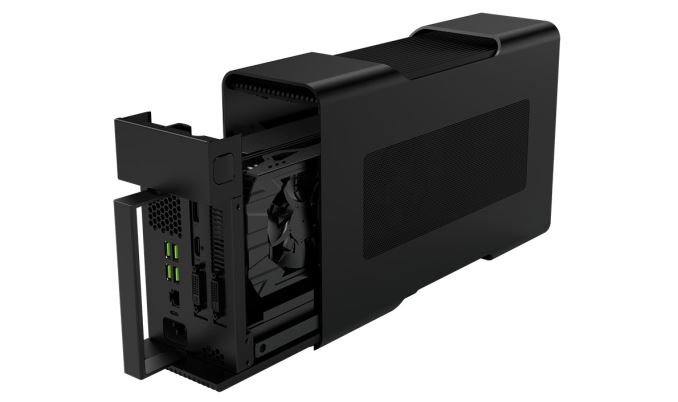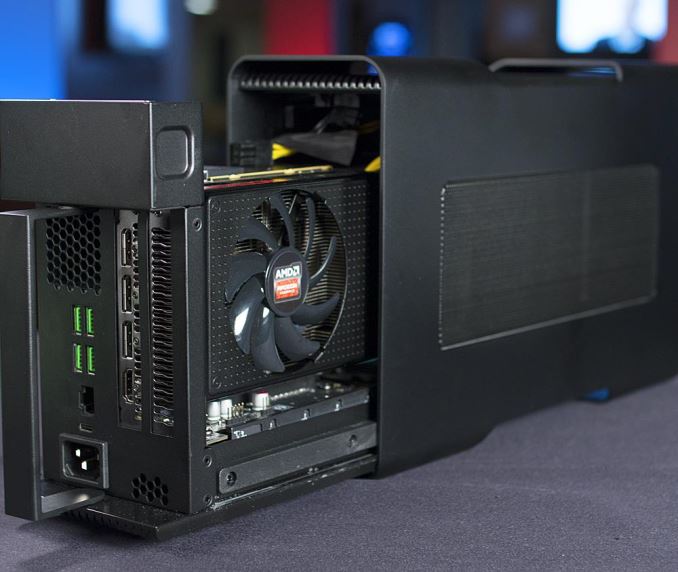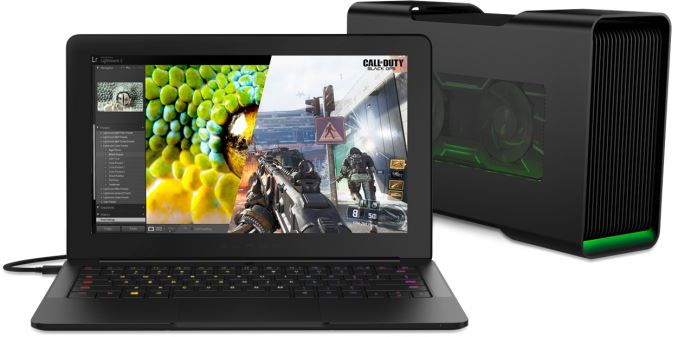Razer Core Thunderbolt 3 eGFX Chassis: $499/$399, AMD & NVIDIA, Shipping In April
by Ryan Smith on March 16, 2016 9:00 PM EST- Posted in
- GPUs
- Thunderbolt
- Razer
- Thunderbolt 3
- eGFX

Back at CES 2016, Razer announced their Core Thunderbolt 3 external graphics (eGFX) chassis. Built around the new Thunderbolt 3 standard and its long-awaited official support for external video cards, the Razer Core is the first eGFX chassis to hit the market. We got a bit more information about it with last week’s AMD XConnect announcement, and now today at GDC Razer is releasing the full details on functionality, compatibility, and availability.
Jumping right into things, the Razer Core is what can be considered a full size eGFX chassis. The unit is large enough to accommodate a double-wide video card up to 12.2 inches long, which covers almost every video card on the market. The only notable exceptions here are cards that use external radiators (e.g. Radeon R9 Fury X) and the small number of ultra-high-end triple-wide card designs such as some of MSI’s Lightning cards. The toolless design is able to handle both open air and blower type video card coolers, however given its smaller size relative to a full PC case, I think it’s going to be worth looking into just how well open air cards do.
| Razer Core Thunderbolt 3 eGFX Chassis Specifications | |||
| Max Video Card Size | Double-Wide, 12.2" Long (310 x 152 x 44mm) |
||
| Max Video Card Power | 375W | ||
| Connectivity | 4x USB 3.0 1x Gigabit Ethernet Laptop Charging via Thunderbolt 3 |
||
| Chassis Size | 4.13 x 13.9 x 8.66 inches (105 x 353 x 220mm) |
||
| Internal PSU | 500W | ||
| System Requirements | Thunderbolt 3 eGFX Certified PC Thundebolt 3 w/Active Cable Windows 10 |
||
| Shipping Date | April 2016 | ||
| Price | $499 ($399 w/Razer laptop) | ||
The chassis itself measures 4.13” x 13.9” x 8.66” and contains an internal 500W PSU, with Razer rating it to drive up to a 375W video card. At 10.89lbs it is technically portable, though clearly not ideal for the task given its handle-less design. Rather Razer intends this to be a fixed docking station for laptop users, as demonstrated both by the additional ports made available on the Core – 4x USB 3.0 Type-A and a gigabit Ethernet port – and by the fact that it’s capable of charging laptops over its Thunderbolt 3 connection.
The Core is the first of what we expect will be several TB3 eGFX chassis. As we briefly mentioned in our AMD XConnect overview, the Core is essentially the pathfinder product for the TB3 eGFX standard, with Intel, AMD, and Razer working together to put together the first devices and validate them. Consequently the Core is so far only validated to work with two laptops – Razer’s Blade Stealth and new 2016 Blade – however it should work with any future laptops that are also eGFX certified.
As for video card compatibility, while the Core was initially developed with Intel and AMD, Razer has confirmed that the chassis does support both AMD and NVIDIA video cards. The full compatibility list is posted below, but for AMD cards it’s essentially all of their latest generation (290 series and newer) video cards. Meanwhile on the NVIDIA side all of the company’s Maxwell 1 and Maxwell 2 cards are supported, starting with the GTX 750 Ti. Though given the price of the Core, it goes without saying that the expectation is that it will be paired up with high-end video cards as opposed to lower-end models.
| Razer Core Video Card Compatibility List | |||
| AMD | NVIDIA | ||
| Radeon R9 Fury | GeForce GTX Titan X | ||
| Radeon R9 Nano | GeForce GTX 980 Ti | ||
| Radeon R9 300 Series | GeForce GTX 980 | ||
| Radeon R9 290X | GeForce GTX 970 | ||
| Radeon R9 290 | GeForce GTX 960 | ||
| Radeon R9 280 | GeForce GTX 950 | ||
| GeForce GTX 750 Ti | |||
While the Core supports both AMD and NVIDIA cards, how well each brand is supported is looking a bit hazy. As part of the eGFX development cycle, AMD’s drivers are fully capable of and validated for eGFX plug ‘n play operation, allowing Windows to gracefully handle losing the external GPU with both planned and accidental disconnects. In the case of an accidental disconnect, Windows will stay up, while applications using the GPU may crash. However NVIDIA’s drivers have not yet been validated for plug ‘n play operation, and it sounds like at this moment NVIDIA is still hammering out the final bugs. That said, NVIDIA has committed to having drivers ready by the time the Core ships in April, so we'll have to see where things stand next month.
Finally, let’s talk about availability and pricing. Razer will begin taking pre-orders for the Core tonight through their website, with the chassis set to ship in April. As for pricing, the first eGFX chassis on the market will not come cheap: Razer is setting the base price on the chassis at $499, and after the cost of a high-end video card to put in the Core, we’re looking at a total price tag of $1000 or more. However Razer is offering a $100 discount on the Core if it’s purchased alongside a Razer Blade or Blade Stealth laptop – bearing in mind that these are the only two laptops eGFX certified at this time in the first place – which brings the effective cost down to $399. Razer also notes that this offer is also retroactive for customers whom already purchased a Blade Stealth earlier this year, as the ultrabook and the Core were announced together at CES and the company doesn’t want to penalize early buyers who were intending to grab the Core anyhow.


















80 Comments
View All Comments
fanofanand - Thursday, March 17, 2016 - link
$400-$500 for the luxury of owning a box to put your graphics card in.......So basically this external box is the same price as a low-end PC. Seems to me that you would be better off with a laptop and a desktop, basically the same price but without the tradeoffs.Sliderpro93 - Thursday, March 17, 2016 - link
Agreed. Box that costs 2-3x average gpu for 1080p hardly makes any sense.I d like that box if it had at least gtx 960 included.
nerd1 - Thursday, March 17, 2016 - link
Dell Graphics Amp was $300, and now given away for almost free with purchase of alienware laptops. It makes more sense to build a complete desktop with $500....WatcherCK - Thursday, March 17, 2016 - link
The price seems to be too high, after reading though the comments $400US is going to become $1000 NZ which puts it into the 'for those with money to burn' category of purchaser :) Maybe one day we have the same kind of box and we can plug our phone in via USB-C (D, E ultrafi?) and use the Galaxy SX's on board mobile Thunderbolt controller (T4M) to let the phone augment itself into a full power desktop machine :)Would the Thunderbolt 3 controller support dual discreet GPUs? Or would that tax the bandwidth the thunderbolt controller has available from the motherboard? (in for a penny in for a pound right, someone is going to get a couple and try it, hell DX12 supports any combination of GPU...)
One thing I would like to see is the ability to direct discrete GPU output though thunderbolt so for example the machine and the displays/peripherals can be physically separate but with no loss of functionality (especially under a heavy use gaming scenario.) Linus (of Linus Tech Tips) recently set something like this up at home, put the hot and noisy machine in another room and run a (what turns out to be insanely expensive) optical thunderbolt cable to where you workstation is setup screens/peripherals etc... https://www.youtube.com/watch?v=NshXgisNly4 (His solution for transferring video from the discreet GPU was to use an Asus ThunderboltEX 2 Dual...)
Sliderpro93 - Friday, March 18, 2016 - link
Plus one has to remember, that TB3 DOES in fact limit high-level performance GPUs, in case you will drive several displays.And it is funny, how razer easy "shaves" 100$ off it. Means its right and its price is close to 200 really.
HWTactics - Friday, March 18, 2016 - link
This is ridiculous. Buy a $300 off-lease Core i5 laptop from Dell Refurbished, throw in a $60 240GB SSD and $20 for an extra 4GB RAM, and you will have a laptop MORE than fast enough for anything non-gaming related for $400.The other $1k will get you one hell of a gaming desktop and you can share files between the two with any of the many, many file sharing solutions (Dropbox, OneDrive, Google Drive, you name it).
And who would buy a Razer laptop, really? Enterprise customers are going to go with Dell, HP or Lenovo for their excellent reliability and business warranties. Home users are going to buy something down the street or online from a brand they recognize.
Wait for more laptops to support this and for more enclosures to be made for a price that belongs on this planet.
osxandwindows - Friday, April 15, 2016 - link
I don't want or need a gaming desktop.gw74 - Sunday, March 20, 2016 - link
double the price of Alienware Graphics Amplifier for no reason. NOPE.maskofwraith - Friday, March 25, 2016 - link
the price is well worth the product. Its a premium product, and a great design. if you want cheaper product look somewhere elselightahead - Monday, April 4, 2016 - link
If you don't wanna get robbed go somewhere else*Yes a cheap PSU and a box with a few ports screams premium...